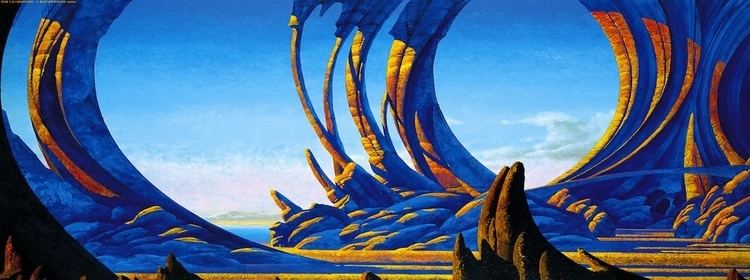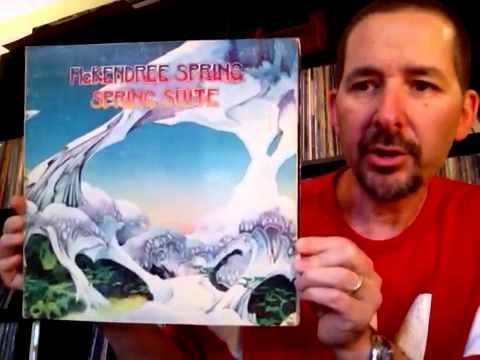Nationality English Name Roger Dean | Role Artist · rogerdean.com Siblings Martyn Dean | |
 | ||
Known for Artist, designer, architect and publisher Awards World Fantasy Award for Best Artist Nominations Chesley Award for Artistic Achievement, Locus Award for Best Art Book Similar People Storm Thorgerson, Vaughan Oliver, Mike Vernon Profiles | ||
The art of roger dean
William Roger Dean (born 31 August 1944), known as Roger Dean, is an English artist, designer, and publisher. He is best known for his work on posters and album covers for musicians, which he began painting in the late 1960s. The artists for whom he did the most art are English rock bands Yes and Asia.
Contents
- The art of roger dean
- Artist roger dean promo
- Early life
- 1960s
- 1970s
- 1980spresent
- Album covers
- Personal life
- Video game covers
- Publications
- References

The covers often feature exotic, fantasy landscapes. His work has sold more than sixty million copies worldwide.

Artist roger dean promo
Early life

William Roger Dean was born on 31 August 1944 in Ashford, Kent. His mother studied dress design at Canterbury School of Art before her marriage and his father was an engineer in the British Army. He has three siblings, brother Martyn and sisters Penny and Philippa. Much of Dean's childhood was spent in Greece, Cyprus, and, from age 12 to 15, Hong Kong, so his father could carry out army duties. Dean was very keen on natural history as a child, and Chinese landscape art and feng shui became particular influences on him during his time in Hong Kong. He has cited landscape, "and the pathways through it", as his greatest influence and source of inspiration.
In 1959, after the family had returned to England, Dean attended Ashford Grammar School followed by his entry in 1961 to Canterbury School of Art studying silversmithing and furniture design and graduated with a National Diploma in Design. He was removed from a life drawing class by the principal for being "young and impressionable", and was informed he could not take it due to maths and physics being his other subjects, leading a switch to studying industrial design. As the school was trying to become accredited in the subject, Dean bypassed its foundation level course but disliked the way the subject was taught and questioned the teachers as to why people had to live in "boxes" and their response in that "form follows function".

Towards the end of the course at Canterbury, Dean was faced with the option of pursuing either architecture or industrial design; one of his tutors thought neither were for him, and recommended that Dean study at the Royal College of Art in London. He enrolled at the college in 1965 to study furniture design and became a student of Professor David Pye. Among his research was the "psychology of architecture" and what made people feel comfortable in buildings. He did a thesis about "producing a sense of tranquillity in domestic architecture". He graduated from the college in 1968 with a masters with first degree honours, and won a silver medal for "work of special distinction". By this time, Dean was interested in "designing the future [...] boxes for people to live in". He considered Rick Griffin's artwork for Aoxomoxoa (1969) by The Grateful Dead as his "first big visual shock" and bought the album prior to owning a record player.
1960s
Among Dean's first successes was his sea urchin chair design which spawned from his research at the Royal College and completed in 1967. He filed a patent for it in the following year. It has been considered to be a predecessor to the bean bag, whereby the chair compresses and fully adapts to the shape and size of the user. The design was completed when Dean was one of the few students picked from the Royal College to design and make objects in famed designer Cherrill Scheer's factory. The chair remains one of Cherrill's favourite pieces. It is now a part of the permanent collection at the Victoria and Albert Museum.
In 1968, during his third year at the Royal College, Dean was assigned a project which involved the design of a contemporary landscape seating area of the upstairs disco at Ronnie Scott's Jazz Club in Soho. This led to the design of his first album cover, The Gun (1968) by rock band The Gun, after owner Ronnie Scott asked him to adapt a demonic-themed design that Dean originally made in his sketchbook for his thesis, for the album's cover. Dean agreed, and was paid "around £5,000" for his work. Dean earned more money from the album's cover than he had done with architecture related work, and realised covers took much less effort. He decided to venture into cover design not purely for the money, but its wider audience and its use "as a propaganda tool [...] showing people what might be and what could be". Dean began to pick up work where he can, including covers for various jazz artists for Vertigo Records which he disliked, calling them "austere exercises" and too restrictive for the ideas he wished to convey. The experience led Dean to establish a commission before starting work he wanted to do, leading to a short period of financial hardship. At the same time, he wanted to release a book on architecture but faced rejection from 27 different publishers.
1970s
Dean designed the logo to the independent label Fly Records in 1970. This led to Dean working on a single for their musician Marc Bolan which involved typesetting the liner notes and lyrics, but Dean had not done the technique before and completed them by hand with the assistance of a graphic designer, in order to show the printing staff where the typesets were to be placed. The positive reaction Dean received from his style of writing led to him handwriting the text for further Bolan singles. This was a similar case for Dean's design for Clear Blue Sky (1970) by Clear Blue Sky, where a painting had been completed except the typesetting, "So to bluff my way through the meeting I had to handwrite it all and hope they would never ask about it". The label were enthusiastic, which gave Dean the confidence to pursue more handwriting, logo, and graphic work.
By 1971, Dean's desire to produce artwork for rock bands had grown though continued with architecture and headed a small exhibition of his work in Florence. Following discussions with A&R man David Howells, who had assigned Dean the sleeve for The Gun, Dean agreed to work on the cover of Osibisa (1971) by Afro-pop band Osibisa. The design is a result of a brief that Dean described as "credible African fairytale imagery" and features "flying elephants and not architecture", which became an early representation of the style he later achieved fame with. Dean considered the job a breakthrough for his career as the design was made into a poster by the Big 'O' poster company which sold a large number of copies. He later said, "From that point on I could do what I wanted".
In mid-1971, during his search for work affiliated with rock bands, Dean sent a portfolio to numerous executives including Phil Carson, the European General Manager of Atlantic Records. Carson took an interest in using Dean for one of his rock acts, Led Zeppelin and Yes, and hired Dean for the cover of Yes's fourth album, Fragile (1971), which marked the beginning of an association with the band to the present day. Dean pitched a story on a creation myth rather than a particular image for it, "about a child who dreamt they were living on a planet that was breaking up, so they had to build a space ark to find another planet to live on. And they towed all the little bits of the planet with them". In 1972, he designed the band's logo which he came up with during a journey on the Brighton Belle train. Yes guitarist Steve Howe said, "There is a pretty tight bond between our sound and Roger's art". In addition to their album covers, Dean also contributed to Martyn Dean's stage set designs for the band.
In 1972, Dean designed the logo for the newly established Virgin Records.
During his work for Yessongs (1973), Dean and his printers Tinsley Robor secured a patent for "a way of going from gatefold to any number of pages, folded out of one piece of card". For Yes's album Relayer (1974), he painted the sleeve in pencil and coloured it with dirty water.
In the late 1970s, Dean had an idea for Living in the Third Millennium, a television show about the designs of the future yet it never made it to production due to budget constraints.
1980s–present
In 1981, Dean and his brother Martyn had their collaborative design, the Tectonic House, a futuristic and economic home built to last, displayed at the annual International Ideal Home Exhibition in Birmingham. The idea spawned from two ideas: Dean's earlier designs for a bed and bedroom intended for the safety of children, and Martyn's "retreat pod" from 1970 that was featured in the Stanley Kubrick film A Clockwork Orange (1971).
In the early 1980s, Dean collaborated with comic artist Michael Kaluta for the video game The Black Onyx (1984) by Henk Rogers. The project involved the pair producing an estimated 4,000 drawings for it, including ideas for its animation, story, music, and motion capture.
Beginning in 1985 Dean created cover artwork for some Psygnosis games, including Shadow of the Beast and Obliterator. He later did the cover art for Tetris Worlds as well as a redesign of the Tetris logo.
Dean received an honorary doctorate from the Academy of Art University in San Francisco in 2002, and an honorary fellowship from the Arts University Bournemouth in 2009.
In 2004, Dean worked on his "Homes for Life" architectural idea, designing affordable futuristic homes that can be mass produced in factories and customised to the user's tastes. The design is curved based and without right angles.
In 2013, Dean filed a legal action in U.S. District Court New York claiming that film director James Cameron was inspired by 14 of his original images in the making the 2009 blockbuster film Avatar. Dean sought damages of $50m. Although the filmmakers admitted in court to being influenced by the artist's work, Dean's case was dismissed in 2014.
In 2013, Dean received a Gold Badge of Merit from the British Academy of Songwriters, Composers and Authors.
Album covers
Known primarily for the dreamy, other-worldly scenes he has created for Yes, Budgie, Uriah Heep, Gentle Giant and other bands, Dean has said, "I don't really think of myself as a fantasy artist but as a landscape painter." Characteristic landscapes show graceful stone arches (as shown in Arches Mist, below) or floating islands, while many paintings portray organic-seeming habitats, such as on the cover of Anderson Bruford Wakeman Howe. Though he primarily works with watercolour paints, many of his paintings make use of multiple media, including gouache, ink, enamel, crayon and collage. In addition to his cover paintings, Dean is respected for his calligraphic work, designing logos and titles to go with his paintings.
Personal life
Dean has a daughter, artist and designer Freyja Dean (b. 1987) who is the inspiration behind the title to Dean's painting Freyja's Castle (1987). Dean lives in Lewes, East Sussex.
Dean described fantasy artist Rodney Matthews as someone who "built his career doing copies of my work, I don't approve of that".
Video game covers
Publications
Others:
